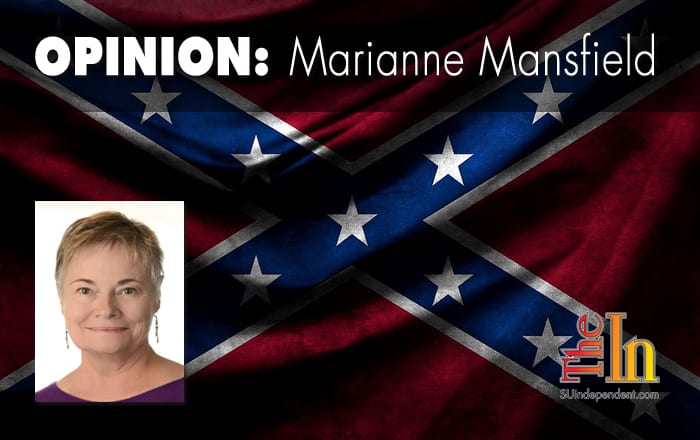 |
| Image: Roger Sayles |
Written by Marianne Mansfield
It’s not about whether the Confederate flag stays or goes. I’m absolutely convinced that if someone gave me a magic wand, and I wiped that flag and every vestige of it from the face of the earth and the memories of its people, it wouldn’t do any good. Those haters committed to the cancers of racism and bigotry would find another image to signal their biases to others.
Should the Confederate flag be removed from state houses? Probably. Maybe it should be housed in a museum with other remnants of the War Between the States. Perhaps there the iterations of the flag’s design which began its existence on the battle flag of Robert E. Lee in northern Virginia could help to explain the mindsets of the people who flew it during those times. Maybe it should share a display with other detritus of slavery, like the neck shackles with bells hanging on attached poles 18 inches above the wearer’s head so that he/she could not move without being heard. I saw that once in a museum. The image has never left me. Sparking a similar response in other museum goers might be reason enough to display it.
But there is this: To the extent that the presence of the Confederate flag wordlessly signals a tolerance for the country’s behavior during the time it was used, an argument can be made for removing it. So as far as it goes, I say sure, get rid of it. Or at least put it in the structural context of a museum.
The Confederate flag, however, is nothing more than a symbol, but it is such a potent one that it is more than capable of diverting attention from the emotionally dynamited discussions of racism.
Take our field of presidential candidates. They scurried like roaches running for cover when the kitchen light comes on, scooting under the edges of the flag. Who called first for its removal? Who cried the loudest? Who did it in another venue? Who cares?
Talk show hosts and pundits alike condemned the flag. It is an emblem of a nefarious time in our nation’s history. Take it down.
Wal-Mart and Amazon puffed up their corporate chests and announced that they would no longer market items emblazoned with the Confederate flag symbol. Great, guys. That will make it all right.
But I wonder this: Would the absence of the Confederate flag on a flagpole in front of the South Carolina capitol building have made a hill of beans worth of difference to Dylann Roof, the shooter in the Charleston killings? Of course it wouldn’t have.
We are wasting time and national effort arguing about the flag. In terms of meaningful change, it’s a non-starter. Will debates about the interpretation of a symbol lead to anything more than more rambling and circular debates? One of my new favorite internet slang terms is LBDN (looking busy doing nothing). I think it applies here.
If we are genuinely interested in meaningful change, where do we begin? We can’t wait for a law, movement, or politician to start the ball rolling. Nothing would be less effective than any of those. All that waiting would simply bring us another two or three more senseless tragedies. What we can do, however, is start at ground zero, which is where we live today.
As much as it dismays me to do so, I feel compelled to dust off a phrase first spoken by President H. W. Bush. In his nomination acceptance speech at the 1988 Republican National Convention, he referred to the “thousand points of light.” The newly minted candidate Bush likened America’s clubs and volunteer organizations to “a brilliant diversity spread like stars, like a thousand points of light in a broad and peaceful sky.”
Unfortunately, we aren’t looking at a broad and peaceful sky in 2015. Again and again, we are exposed to the flames of hatred and racial bigotry. But a point of light doesn’t come by that characterization unless it can be picked out even against abject darkness or fiery conflagration.
Points of light exist. In the aftermath of the Charleston killings, we are being buoyed by them.
I’m in Michigan as I write this. On a steamy summer evening, an event called the Call to Action Healing Gathering was put together by the Grand Rapids Office of Diversity and Inclusion. It aimed to promote dialogue to help race relations. First Community AME Church and St. Luke AME Zion Church also helped organize it. One of the organizing ministers, Reverend Gerry Moore, told a reporter that “sometimes hate crimes are committed because people simply don’t understand one another.” That, my friends, is a point of light.
And let me close with one other point of light. Think back to what you heard the families of Dylan Roof’s victims tell him at his arraignment. “We forgive you.” “We love you.”
That point of light is enough to give us all hope that we can strive for meaningful change.
It isn’t about the damned flag. It is about heeding the points of light we find as we move forward.




